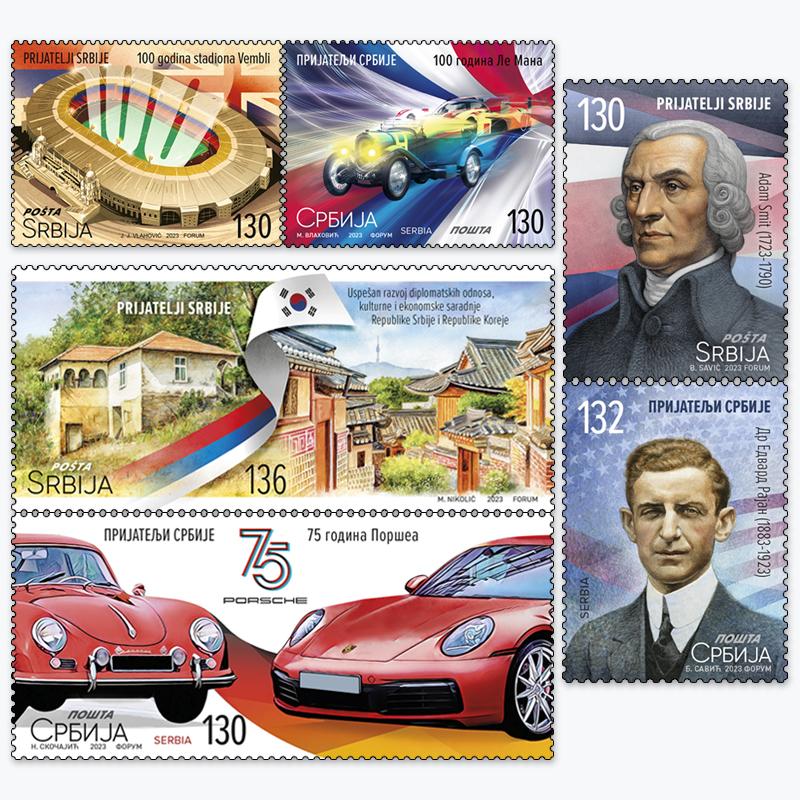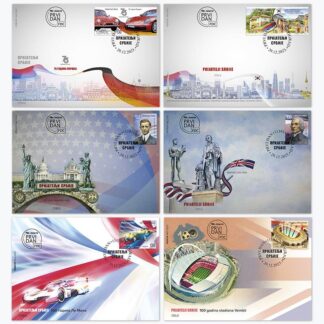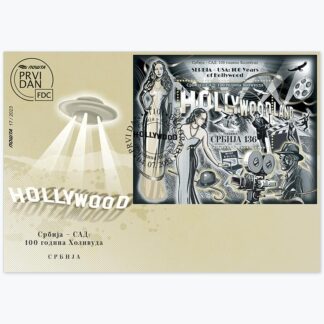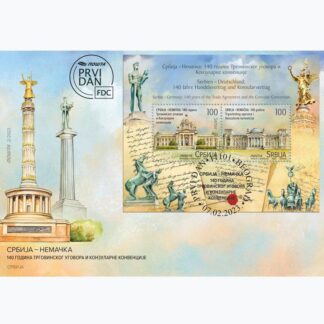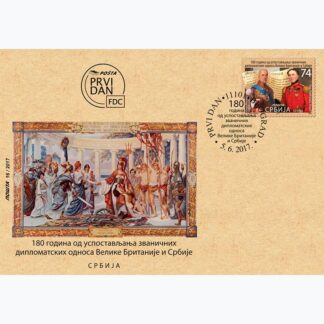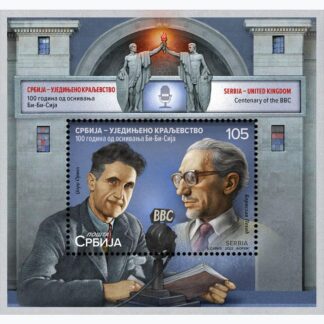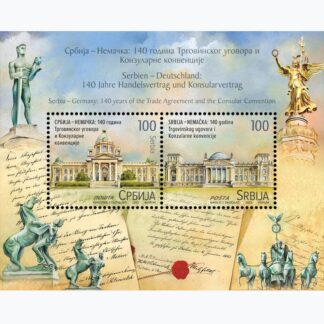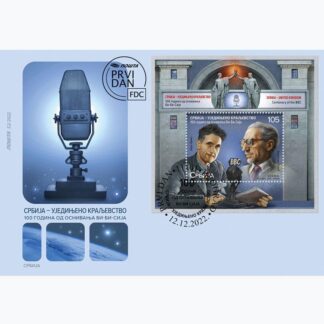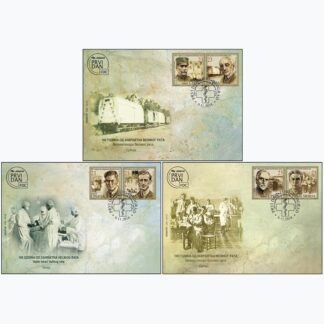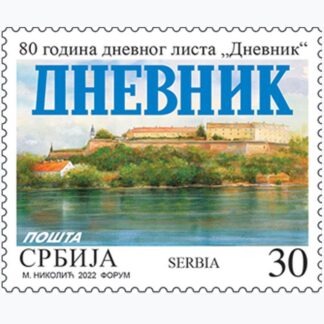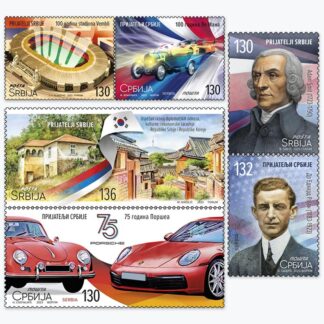Description
75 years of Porsche
With the desire to express the importance of the economic ties between Serbia and Germany, PE “Pošta Srbije” (Post of Serbia) issues a commemorative postage stamp on the occasion of the great jubilee of the German car manufacturer - 75 years of Porsche sports car. Synonymous with superior engineering, quality, luxury and reliability, the Porsche company best reflects the trust that customers of German companies' products and services have in Serbia and the reputation they enjoy in our country.
Postage stamp motif: Porsche 356 coupé, the first sports car of the Porsche company, constructed in 1948; Porsche 911 model 992, the company's latest sports car, in production since 2019; the company's original jubilee logo.
Motifs on the rands: the silhouette of Stuttgart, the headquarters of the Porsche company and the silhouette of Belgrade; the original logo of the Porsche company and the jubilee logo.
Expert collaboration: Porsche SCG d.o.o. and "Svetozar Marković" University Library, Belgrade.
Graphic realization: MA Nadežda Skočajić, Academic Graphic Artist
Successful development of diplomatic relations, cultural and economic cooperation between the Republic of Serbia and the Republic of Korea
Successful bilateral cooperation and good and friendly relations between the Republic of Serbia and the Republic of Korea have lasted since the establishment of diplomatic relations in 1990, and in recent years these relations have been characterized by the intensification of high-level political dialogue and improvement of overall cooperation, especially on the economic level.
From the beginning of the sixties of the last century until today, South Korea has experienced exceptional economic growth, which has placed this country in one of the 15 largest economies in the world, hence the economic cooperation between the Republic of Serbia and the Republic of Korea is growing, especially in the area of investments by South Korean companies in Serbia, which have had a significant upward trend in recent years.
Decades of fruitful economic and cultural cooperation and mutual assistance between the two countries during the coronavirus pandemic strengthened the foundations for the further expansion of bilateral relations between Serbia and South Korea, and trade, energy, eGovernment, waste management, agriculture, education, culture and tourism are just a few from areas in which the two countries have common interests.
The record volume of trade between the two countries that was achieved in previous years, the improvement of cooperation in the field of tourism by signing the Agreement on air transport between the two countries, and the improvement of cooperation in the field of culture, art and education, along with intensive political dialogue and mutual understanding, are a guarantee of stability and progress in the field of diplomatic relations between the Republic of Serbia and the Republic of Korea and in the following decades.
Expert collaboration: ”Svetozar Marković” University Library, Belgrade
Artistic realization of the issue: Miroslav Nikolić
Dr. Edward Ryan (1883-1923)
Dr. Edward Ryan, an American physician of Irish origin (Scranton, Pennsylvania, 14 December, 1883 - 18 September, 1923, Tehran) was an extraordinary person who left an indelible mark on history, especially when it comes to his role during the First World War and helping the Serbs.
He gained a reputation as a fearless doctor, humanitarian and diplomat in the civil wars in Mexico and Russia, and especially in the Great War in Europe. During the First World War, Serbia faced severe challenges, including occupation and mass casualties. Dr. Ryan recognized the need for urgent medical assistance to the brave Serbian army and people and immediately went into action. With two surgeons and 12 nurses, on behalf of the American Red Cross, he arrived in half-destroyed Belgrade on 16 October, 1914, where he organized a hospital for the treatment of the wounded and civilians.
His devotion and dedication to medical care and saving lives was impressive. During the war, he operated on more than eight thousand people, he also fought typhus, saving tens of thousands of lives. Dr. Ryan and his colleagues worked under extremely difficult conditions, often without sufficient medical equipment and resources, but their dedication and commitment brought hope and relief to thousands of wounded soldiers. In addition to medical aid, Dr. Ryan informed the American public about the reality of the war in the Balkans with his authentic letters and reports, raising awareness among Americans about the suffering of the Serbs.
The Kingdom of Serbia decorated him with the Order of the White Eagle, the Republic of France presented him with the Legion of Honour, but he also received the decoration of Austria-Hungary because he took care of the Austro-Hungarian wounded when the Austro-Hungarian army retreated from Belgrade. Dr. Edward Ryan remains an unforgettable figure in Serbian history, a symbol of friendship and solidarity between the USA and Serbia in difficult times, and his selfless commitment to the rescue and treatment of Serbian soldiers during the First World War left a deep and lasting mark on the history of the two nations.
Expert collaboration: ”Svetozar Marković” University Library, Belgrade
Artistic realization of the issue: Boban Savić MA, academic painter
Adam Smith (1723-1790)
Adam Smith (Kirkcaldy, June 16, 1723 - Edinburgh, July 17, 1790) was a Scottish economist, philosopher and ethicist whose contributions to economic theory left a deep and lasting impact on the development of modern economic ideas and systems. Smith was one of the most influential thinkers of the 18th century, and his most famous work, The Wealth of Nations, published in 1776, is a classic of economics and political economy literature.
Adam Smith was a prominent Scottish thinker whose works shaped our understanding of economic theory and practice. His idea of the invisible hand and advocacy of the free market remain key components of contemporary economic thought and political systems. In his Wealth of Nations, Smith developed key concepts that shaped the way we understand economics. One of those concepts is the "invisible hand". Namely, Smith argued that, although people often act for selfish reasons, the market directs them to serve the general interest with their actions. In other words, the market has the ability to self-organize and self-correct. Smith also promoted the idea that a free market, in which trade and competition are unimpeded, leads to economic efficiency and growth in wealth, and this idea is the basis of capitalism as an economic doctrine today.
In addition to his economic contributions, Smith also considered moral philosophy. In his earlier work "The Theory of Moral Feelings", he investigated the natural basis of moral feelings and the creation of moral values. He worked as a professor at the University of Glasgow and left a profound impact on many generations of economists and philosophers, and his ideas continue to be the subject of academic discussions and political debates around the world today.
Expert collaboration: University Library “Svetozar Marković“
Artistic realization of the stamp: Boban Savić MA, academic painter. Artistic realization of the envelope: Miroslav Nikolić.
100 years of the "24 Hours of Le Mans" car race
The "24 Hours of Le Mans" race is one of the most prestigious car races in the world, and its rich history spanning a century began in 1923, precisely in Le Mans. The idea for the race came from journalists and promoters Charles Farroud and George Durand. The first race, in which 33 teams participated, was an opportunity for car manufacturers to test their vehicles in extreme conditions. The first Le Mans races were dominated by British and Italian teams and drivers - Bugattis, Bentleys, Alfa Romeos... After an interruption during the Second World War, the race was held again in 1949, attracting more and more visitors and teams from all over the world. The golden era of the "24 Hours of Le Mans" was the period during the 1960s, when the epic sports battles between Ferrari and Ford were held, and this era will be remembered for four consecutive wins by Ford with the GT 40 model in the period 1966-1969. The 1970s and 1980s bring the dominance of Porsche with the 917 and 956/962 models, Audi's successful attempts to participate in endurance racing with cars powered by diesel fuel, the entry of Toyota, Peugeot and numerous other manufacturers into endurance racing... Over the course of a century, many drivers became legends of this race, among them the most famous Jackie X, Phil Hill, Derek Bell, Frank Biella and the most successful in the history of this race ever - "Mr. Le Mans" - Tom Christensen with the greatest number of victories in history these races - a total of nine victories from the debut race in 1997 to the last triumph achieved in 2013.
Expert collaboration: ”Svetozar Marković” University Library, Belgrade
Artistic realisation of the issue: MA Marija Vlahovic, academic graphic artist
100 years of Wembley Stadium
One of the most famous sports buildings in the world, Wembley Stadium in London, this year marks the centenary of its rich history, which it entered immediately after its opening in 1923 during the FA Cup final between Bolton Wanderers and West Ham United, better known as the "white horse final ". This match got its name from the white police horse Billy who, due to the huge number of spectators (estimated to be around 200,000) "cleared" the congested surroundings of the stadium and the stadium itself, so that King George V could attend the match. Wembley Stadium has hosted four FIFA World Cups, in 1930, 1966, 1996 and 2018, and the 1966 final would also go down as the moment England won their first and only World Cup. In addition to football, Wembley also hosted dog races before the Second World War, rugby union cup finals, boxing matches, motorcycle races, and history records that the first television broadcast of the FA Cup final from Wembley was in 1938. The first post-war Olympic Games in 1948 were also held at Wembley, and the spotlights shone for the first time in 1955 on the football match between England and Spain, while in 1961 one of the most amazing competitions in the history of Wembley was held - the night ski jumping competition! On the centenary of the Football Association of England, in 1963, Wembley got a roof, and in 1969, the audience saw and heard musicians for the first time, at a concert by the group YES. Pope John Paul II celebrated mass at Wembley in 1982, and in 1985 Wembley was one of the hosts of the global music event - the Live Aid concert. It entered the new millennium stadium after the last match played in 2000, so that the new Wembley Arena was officially opened in 2007 with a match between England and Germany. Today, Wembley is owned by the Football Association of England (FA), hosts the FA Cup final and is the home stadium of the England national football team.
Expert collaboration: ”Svetozar Marković” University Library, Belgrade
Artistic realization of the issue: MA Jakša Vlahović, academic graphic artist
